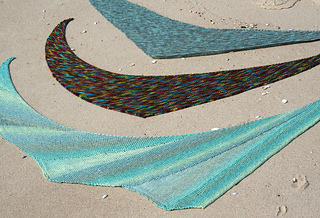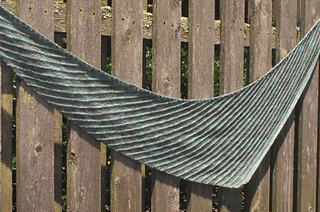patterns >  Sarah Montie Handknits
Sarah Montie Handknits
> Good to the Last Drop, 3 Easy Side to Side Shawls













Good to the Last Drop, 3 Easy Side to Side Shawls
Sometimes you just want an easy project that you don’t have to think about a lot, but you don’t want to be bored either. This pattern is easy enough for the beginner knitter, but interesting enough for the more advanced knitter. It’s perfect for that one skein of fingering weight yarn you just bought or have in your stash. Although all samples are knit with fingering weight yarn, other weights can be used.
It could just replace sock knitting for that easy purse project.
Instructions for three different shawls all based on the same formula, are included in this pattern. Start with five stitches, and work increases and decreases for a graceful asymmetrical wide triangular shawl. Continue until you use up your yarn. Perfect for that special yarn that you want to use every inch of, “good to the last drop”. Great for any kind of yarn; handspun, any weight, solids to variegated to gradients.
All techniques used are explained.
• K2tog (knit 2 stitches together) and YO (yarn over), are used for all versions.
• Version A has a repeating pattern of 6 rows, 4 are knit and 2 are purl.
• Version B is all knit, but beads are added along one edge and the bind off row. The beads are added as you knit, they are not pre-strung. For a really easy version you can eliminate the beads, but it could lead to boredom.
• Version C includes simple short rows; you do not wrap any stitches (if you have never done short rows, this is a perfect first project). If you want to wrap the stitches and hide the wraps you can, but I don’t describe this technique.
Skill level: Advanced beginner; version C is a little more complicated than A & B.
Some things that make this pattern easy:
- All shaping is worked on the front of the work. The back side is only either knit or purl.
- No complicated stitches.
- Visual clues can be used to remind you what to do so you don’t always have to refer to the pattern.
- Each shawl is basically a repeat of 4 to 6 rows.
- I use yarn overs for the increase because they are easy to see and they become a reminder of when and where to make the increases.
Yarn: Any fingering weight yarn can be used to make these shawls. Versions A & B each used 3.5oz or close to 100g of fingering weight yarn, which happened to be 430yds for this yarn. Less yarn could be used, or more. You can also use a different weight yarn; that is the beauty of this pattern, it is up to you. (For version B if you use a heavier yarn I would suggest a larger bead, size 2/0, and a larger crochet hook, up to size 1.75mm.) For whatever yarn you use, just use a larger size needle than recommended on the label, by one, two, or three sizes, to give your fabric a nice drape. For thinner yarn, go up more needle sizes than for thicker yarn.
Pattern notes
The shawls are knit from side to side, starting at one end with five stitches. At the beginning edge one decrease is made and on the other edge two increases are made on every right side row, creating a shallow asymmetrical triangle with a crescent shape. These stitches are then bound off when you are almost out of yarn.
Sizes: Version A is larger than version B using the same amount of yarn, because garter stitch (version B)
knits up more compactly than stockinette stitch (version A is primarily stockinette stitch). Version C is is a slightly different shape because of the short rows.
Sizes after blocking.
Version A: 72in/183cm wide, 12in/31cm deep
Version B: 65in/165cm wide, 12in/31cm deep
Version C: 64in/163cm wide, 13in/33cm deep
7861 projects
stashed
9547 times
- First published: September 2014
- Page created: September 9, 2014
- Last updated: November 16, 2014 …
- visits in the last 24 hours
- visitors right now




